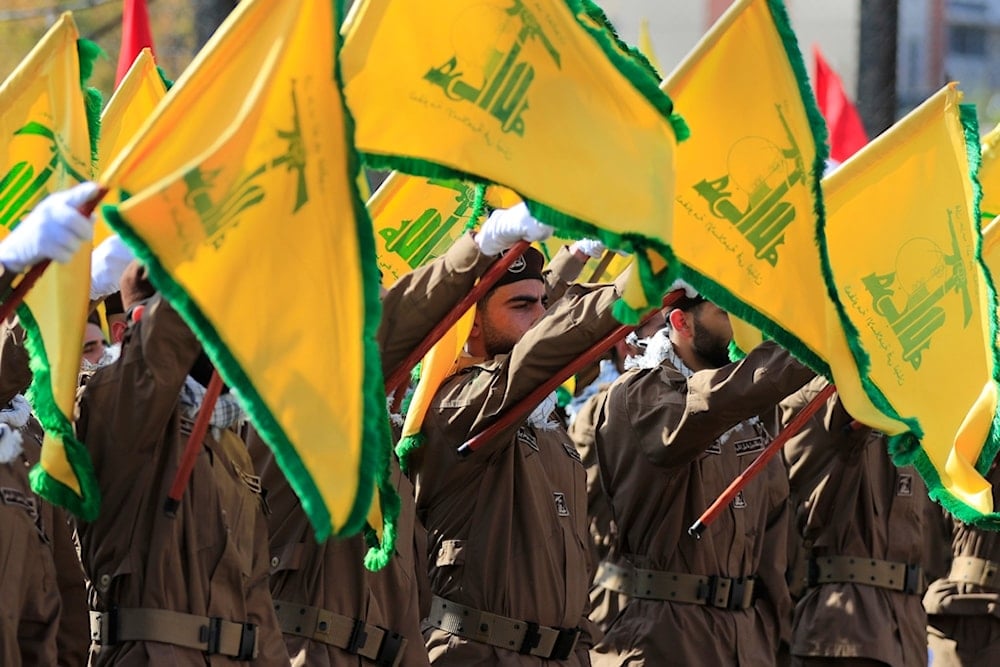Gantz's claim of taking apart Hezbollah’s power in days discredited
The Lebanese Resistance group's capabilities continue to pose a challenge to the Israeli occupation military.
-

Hezbollah fighters raise their group flags during the funeral of commander Ismail Baz, who was killed in an Israeli drone strike, in Chehabiyeh village, south Lebanon, Wednesday, April 17, 2024. (AP)
Former Israeli War Cabinet member Benny Gantz threatened on Tuesday that "Israel" "can plunge Lebanon completely into the dark and take apart Hezbollah’s power in days," marking another pointed threat from an Israeli official as tensions with Lebanon and Hezbollah escalate, CNN reported Thursday.
Ben Wedeman indicates in his analysis piece that "Israel’s" ability to disrupt Lebanon's already fragile power grid, which has been weakened by years of mismanagement and economic decline, seems feasible, pointing out that strategic airstrikes could easily cripple the country's electrical infrastructure.
"Taking apart Hezbollah’s power in days, however, is a far taller task," he emphasized.
Since the July 2006 war with Hezbollah, "Israel" has been after a retaliatory round, and the Lebanese Resistance group has long been preparing for it.
According to Israeli estimates, the Lebanese Resistance group has at least 150,000 missiles and rockets in its arsenal, with 5,000 projectiles already launched since October 2023, leaving much of its arsenal intact, as mentioned by Hezbollah Secretary General Sayyed Hassan Nasrallah in his latest speech.
The writer recalls that Israeli officials have been taken aback by the sophistication of Hezbollah’s recent attacks, which include precise strikes on "Israel's" espionage outposts along the border with Lebanon, downing advanced Israeli drones, and targeting Iron Dome batteries and anti-drone defenses.
"Perhaps the biggest surprise for Israel, however, was the nine minutes of drone footage Hezbollah published online of highly sensitive civilian and military infrastructure in and around the northern city of Haifa," Wedeman suggests.
Hezbollah also reportedly has between 40,000 and 50,000 fighters, the writer says, with Sayyed Nasrallah confirming that the number is over 100,000, many of whom have combat experience from the Syrian war.
Wedeman goes on to boast about Hezbollah's "highly trained and disciplined" fighters.
"During the 2006 war, in the experience of this correspondent, it was rare to encounter Hezbollah fighters. One day we came upon several of them in the ruins of a southern Lebanese village. They were polite but firm, devoid of boastful bluster and swagger, insisting we leave immediately for our own safety. They wouldn’t take no for an answer."
He notes that, unlike Gaza, Lebanon benefits from strategic depth and supportive leadership in Syria and Iraq, facilitating direct access to Iran, pointing out that, despite "Israel’s" frequent strikes on targets in Syria allegedly involved in arms transfers to Hezbollah, these efforts have had limited success.
Wedeman believes that in the event of a full-scale war, both "Israel" and Hezbollah would be capable of inflicting significant damage on each other.
In the same context, he points out that "looking across the Middle East, the strategic balance that for so long favored Israel is changing," with the Israeli entity now facing non-state actors like Hezbollah, Hamas, the Palestinian Islamic Jihad movement, Ansar Allah, and the Resistance factions in Iraq and Syria, alongside Iran.
"And because of US support for Israel, all of these players also have the US, and Western interests in the Middle East, in their crosshairs," he highlights.
Read more: Hezbollah, Yemen drone downing challenge 'Israel', US air dominance
'Israel' damaged more than 12 million square meters of Lebanese agricultural land
In a related context, the Financial Times reported that over nearly nine months of fighting with Hezbollah, the Israeli military "has laid waste to swaths of southern Lebanon."
The news outlet stressed that Israeli attacks have devastated buildings, infrastructure, farmland, and forests. In many of the frontier villages and towns, entire neighborhoods have been destroyed.
Most of this destruction has occurred within a five kilometer corridor just north of the Blue Line, the UN-drawn border between Lebanon and occupied Palestine the two countries, according to an analysis of satellite imagery, radar data, government statistics, and interviews with local and state officials, researchers, civil defense workers, and residents.
Data gathered by the Financial Times suggests that as diplomatic negotiations to ease tensions falter, the Israeli military "has used force to create a new reality on the ground."
Near-daily aerial bombardments, artillery shelling, and the use of incendiary white phosphorus have rendered much of the area north of the Blue Line uninhabitable, the news website highlighted.
It suggested that "structural damage, environmental degradation and economic harm have left a strip of land resembling the "'buffer zone' that Israel wants to establish in Lebanon."
Hashem Haidar, head of Lebanon’s Southern Council, mentioned that more than 3,000 houses have been completely destroyed, with 12,000 others suffering medium-level damage.
According to the official, more than 12 million square meters of agricultural land have been damaged, with olive orchards, banana farms, and citrus groves withering due to "Israel’s" use of white phosphorus and other incendiaries. Livestock and beehives have also been destroyed.
Haidar estimated the damage costs exceed $1.7 billion.
While "Israel" claims it has pushed some elite Hezbollah units farther from the border, the Lebanese Resistance group's capabilities appear largely intact, with the group showcasing new weaponry such as missile-firing drones.
Read more: US warns 'Israel' of limited capabilities against Hezbollah: FT

 5 Min Read
5 Min Read








